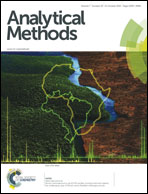Determination of inorganic anions in oilfield water using capillary electrophoresis with indirect fluorescence detection†
Abstract
Analysis of high salinity oilfield water for anions presents challenges. Here we develop a capillary electrophoresis method using indirect fluorescence detection for simultaneous separation and determination of bromide, chloride, nitrate and sulfate. 8-Hydroxypyrene-1,3,6-trisulfonic acid (HPTS) is used as the fluorescent probe in the background electrolyte. High resolution (8.5) between chloride and sulfate is achieved using an acidic BGE (pH 2.0) under reversed polarity. This method is capable of detecting trace anions in high chloride samples (5 ppm Br− in 30 ppm Cl−, 1 ppm NO3− in 400 ppm Cl−, 1.5 ppm SO42− in 1500 ppm Cl−). Linear calibration (R2 > 0.99) was achieved for sulfate over the range 1–20 ppm in 500 ppm chloride. Limits of detection (LOD) were 0.4 ppm for sulfate and 1.4 ppm for chloride. This method was applied to the determination of chloride and sulfate in high salinity oilfield water samples, with 9% RSD for chloride and 84% spike recovery for sulfate.


 Please wait while we load your content...
Please wait while we load your content...